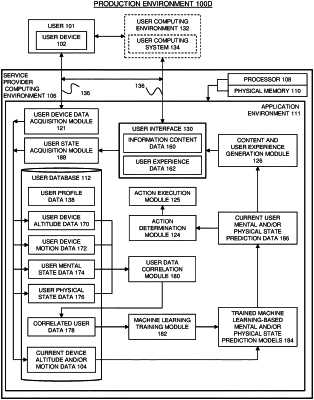| CPC G16H 50/30 (2018.01) [G06F 17/15 (2013.01); G16H 20/70 (2018.01); G16H 50/20 (2018.01)] | 28 Claims |

|
1. A computing system implemented method comprising:
identifying one or more physical medical conditions of one or more users of an application;
collecting objectively measured altitude data from one or more remote monitoring devices associated with the one or more users of the application;
identifying, based on the objectively measured altitude data, a specific physical activity being performed by the one or more users during a defined period of time, wherein a number of occurrences of the specific physical activity in the defined period of time provides an indication of a status of the identified physical medical conditions;
generating physical activity count data representing data associated with the number of occurrences of the specific physical activity being performed by each of the one or more users in the defined period of time;
for each of the one or more users, obtaining mental state data for the user during the defined period of time in which the user is performing the specific physical activity;
for each of the one or more users, correlating that user's mental state data with that user's physical activity count data;
collecting and processing the correlated mental state data and physical activity count data for each of the one or more users to generate machine learning-based mental state prediction model training data;
providing the machine learning-based mental state prediction model training data to one or more machine learning-based prediction models to generate one or more trained machine learning-based mental state prediction models;
identifying a prior diagnosis of one or more physical medical conditions of a current user, wherein the current user is a user other than the one or more users;
providing the current user with a digital therapeutic application;
providing the current user with a graphical user interface to the digital therapeutic application by which therapeutic treatment content is provided to the current user, wherein the therapeutic treatment content provides treatment for the one or more previously diagnosed physical medical conditions of the current user;
collecting, by one or more processors of the digital therapeutic application, objectively measured current altitude data from one or more remote monitoring devices associated with the current user of the digital therapeutic application;
identifying, based on the objectively measured current altitude data, a specific physical activity currently being performed by the current user, wherein a number of occurrences of the specific physical activity in the defined period of time provides an indication of a status of the one or more previously diagnosed physical medical conditions of the current user;
generating current physical activity count data representing data associated with the number of occurrences of the specific physical activity currently being performed by the current user in the defined period of time;
providing the current physical activity count data to the one or more trained machine learning-based mental state prediction models;
receiving current user mental state prediction data from the one or more trained machine learning-based mental state prediction models; and
based, at least in part, on the current user mental state prediction data received from the one or more trained machine learning-based mental state prediction models, modifying, by one or more processors of the digital therapeutic application, the therapeutic treatment content provided to the current user through the graphical user interface of the digital therapeutic application, wherein the modified therapeutic treatment content provides treatment for the one or more previously diagnosed physical medical conditions of the current user.
|